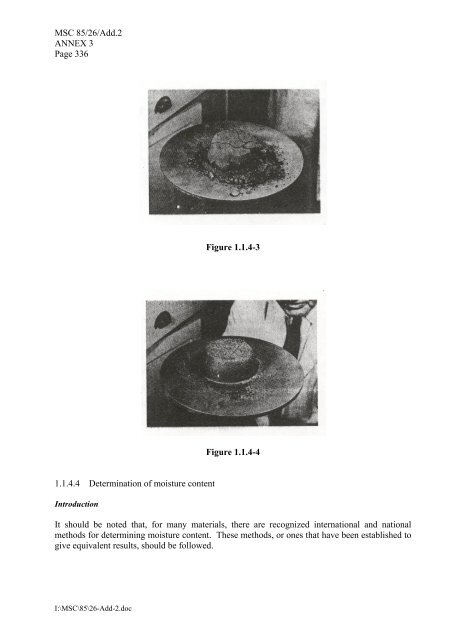MSC 85/26/Add.2 ANNEX 3 RESOLUTION MSC.268(85) - US Coast ...
MSC 85/26/Add.2 ANNEX 3 RESOLUTION MSC.268(85) - US Coast ... MSC 85/26/Add.2 ANNEX 3 RESOLUTION MSC.268(85) - US Coast ...
MSC 85/26/Add.2ANNEX 3Page 336Figure 1.1.4-3Figure 1.1.4-41.1.4.4 Determination of moisture contentIntroductionIt should be noted that, for many materials, there are recognized international and nationalmethods for determining moisture content. These methods, or ones that have been established togive equivalent results, should be followed.I:\MSC\85\26-Add-2.doc
MSC 85/26/Add.2ANNEX 3Page 337Concentrates and similar materialsIt is clearly important that the samples should be dried to a constant mass. In practice, this isascertained after a suitable drying period at 105 o C by weighing the sample successively with aninterval of several hours elapsing. If the mass remains constant, drying has been completed,whereas if the mass is still decreasing, drying should be continued.The length of the drying period depends upon many variables, such as the disposition of thematerial in the oven, the type of container used, the particle size, the rate of heat transfer, etc.It may be that a period of five hours is ample for one concentrate sample, whereas it is notsufficient for another. Sulphide concentrates tend to oxidize, and therefore the use of dryingovens with air circulation systems is not recommended for these materials, nor should the testsample be left in the drying oven for more than four hours.CoalThe recommended methods for determination of the moisture content are those describedin ISO 589-1974, “Hard Coal – Determination of Total Moisture”. This method, or ones thathave been established to give equivalent results, should be followed.Calculation of moisture content, FMP and transportable moisture limit:Taking m 1 as the exact mass of the subsample “as received” (see 1.1.4.1),Taking m 2 as the exact mass of the “as received” subsample, after drying,Taking m 3 as the exact mass of the sample just above the flow state (see 1.1.4.3),Taking m 4 as the exact mass of the sample just above the flow state, after drying,Taking m 5 as the exact mass of the sample just below the flow state (see 1.1.4.3),Taking m 6 as the exact mass of the sample just below the flow state, after drying,Then:.1 The moisture content of the concentrate “as received” is:( m1− mm12)× 100, in per cent(1.1.4.4.1).2 The FMP of the material is:( m3− m4) m5− m6+m m325× 100, in per cent(1.1.4.4.2).3 The transportable moisture limit of the material is 90% of the FMP.I:\MSC\85\26-Add-2.doc
- Page 286 and 287: MSC 85/26/Add.2ANNEX 3Page 286CHARA
- Page 288 and 289: MSC 85/26/Add.2ANNEX 3Page 288SEED
- Page 290 and 291: MSC 85/26/Add.2ANNEX 3Page 290SILIC
- Page 292 and 293: MSC 85/26/Add.2ANNEX 3Page 292DISCH
- Page 294 and 295: MSC 85/26/Add.2ANNEX 3Page 294SODIU
- Page 296 and 297: MSC 85/26/Add.2ANNEX 3Page 296SODIU
- Page 298 and 299: MSC 85/26/Add.2ANNEX 3Page 298STAIN
- Page 300 and 301: MSC 85/26/Add.2ANNEX 3Page 300SUGAR
- Page 302 and 303: MSC 85/26/Add.2ANNEX 3Page 302SULPH
- Page 304 and 305: MSC 85/26/Add.2ANNEX 3Page 304SULPH
- Page 306 and 307: MSC 85/26/Add.2ANNEX 3Page 306SUPER
- Page 308 and 309: MSC 85/26/Add.2ANNEX 3Page 308TACON
- Page 310 and 311: MSC 85/26/Add.2ANNEX 3Page 310TANKA
- Page 312 and 313: MSC 85/26/Add.2ANNEX 3Page 312TAPIO
- Page 314 and 315: MSC 85/26/Add.2ANNEX 3Page 314VANAD
- Page 316 and 317: MSC 85/26/Add.2ANNEX 3Page 316VERMI
- Page 318 and 319: MSC 85/26/Add.2ANNEX 3Page 318WOODC
- Page 320 and 321: MSC 85/26/Add.2ANNEX 3Page 320WOOD
- Page 322 and 323: MSC 85/26/Add.2ANNEX 3Page 322EMERG
- Page 324 and 325: MSC 85/26/Add.2ANNEX 3Page 324DISCH
- Page 326 and 327: MSC 85/26/Add.2ANNEX 3Page 326CARRI
- Page 328 and 329: MSC 85/26/Add.2ANNEX 3Page 328VENTI
- Page 330 and 331: MSC 85/26/Add.2ANNEX 3Page 3301.1.2
- Page 332 and 333: MSC 85/26/Add.2ANNEX 3Page 332Conse
- Page 334 and 335: MSC 85/26/Add.2ANNEX 3Page 334I:\MS
- Page 338 and 339: MSC 85/26/Add.2ANNEX 3Page 338Peat
- Page 340 and 341: MSC 85/26/Add.2ANNEX 3Page 3401.2.3
- Page 342 and 343: MSC 85/26/Add.2ANNEX 3Page 342Figur
- Page 344 and 345: MSC 85/26/Add.2ANNEX 3Page 344Figur
- Page 346 and 347: MSC 85/26/Add.2ANNEX 3Page 346Figur
- Page 348 and 349: MSC 85/26/Add.2ANNEX 3Page 3481.3 P
- Page 350 and 351: MSC 85/26/Add.2ANNEX 3Page 350.2 De
- Page 352 and 353: MSC 85/26/Add.2ANNEX 3Page 3522 Tes
- Page 354 and 355: MSC 85/26/Add.2ANNEX 3Page 3542.1.5
- Page 356 and 357: MSC 85/26/Add.2ANNEX 3Page 356and a
- Page 358 and 359: MSC 85/26/Add.2ANNEX 3Page 3583.1.2
- Page 360 and 361: MSC 85/26/Add.2ANNEX 3Page 3604 Tro
- Page 362 and 363: MSC 85/26/Add.2ANNEX 3Page 3624.2.2
- Page 364 and 365: MSC 85/26/Add.2ANNEX 3Page 364the t
- Page 366 and 367: MSC 85/26/Add.2ANNEX 3Page 36612345
- Page 368 and 369: MSC 85/26/Add.2ANNEX 3Page 368APPEN
- Page 370 and 371: MSC 85/26/Add.2ANNEX 3Page 370MATER
- Page 372 and 373: MSC 85/26/Add.2ANNEX 3Page 372MATER
- Page 374 and 375: MSC 85/26/Add.2ANNEX 3Page 374MATER
- Page 376: MSC 85/26/Add.2ANNEX 3Page 376MATER
<strong>MSC</strong> <strong>85</strong>/<strong>26</strong>/<strong>Add.2</strong><strong>ANNEX</strong> 3Page 336Figure 1.1.4-3Figure 1.1.4-41.1.4.4 Determination of moisture contentIntroductionIt should be noted that, for many materials, there are recognized international and nationalmethods for determining moisture content. These methods, or ones that have been established togive equivalent results, should be followed.I:\<strong>MSC</strong>\<strong>85</strong>\<strong>26</strong>-Add-2.doc



